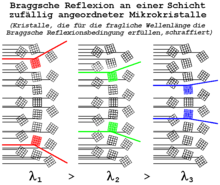Electron diffraction tube
An electron diffraction tube is a special cathode ray tube that enables the observation and investigation of the wave properties of electrons through interference . It is mainly used for this purpose in teaching.
background
According to the theory of matter waves that Louis-Victor de Broglie postulated in 1924, wave properties are also ascribed to each particle. The electron diffraction tube supports this theory by demonstrating interference for electrons, a phenomenon that occurs only with waves, but not with classical particles. The proof of de Broglie's matter waves (first in the Davisson-Germer experiment in 1927) led to the wave-particle dualism in physics.
construction
In an evacuated glass flask, an electron gun generates a focused electron beam with the help of the Wehnelt cylinder . This hits a polycrystalline graphite foil on which it is greatly expanded by scattering . At the end of the glass bulb, the electrons are detected by a fluorescent screen.
Bragg reflection on graphite
Tiny crystal fragments are randomly arranged in the graphite foil. The Bragg reflection of the electrons on such a crystal fragment only provides an interference maximum if the crystal fragment is oriented at a glancing angle to the incident beam. This interference maximum is then found for the emerging beam at twice the glancing angle. Since these angles are rotationally symmetrical to the beam axis, the interference maxima on the fluorescent screen result in concentric circles. This generation of interference is in principle identical to the Debye-Scherrer method , in which X-rays are scattered on a polycrystal. Since the phenomena of scattering and interference play the main roles in the electron diffraction tube, its name is somewhat misleading.
Individual evidence
- ↑ Electron diffraction tube at LEIFI Physik. Retrieved January 10, 2019 .


